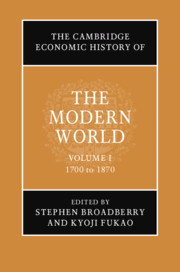Book contents
- The Cambridge Economic History of the Modern World
- The Cambridge Economic History of the Modern World
- The Cambridge Economic History of the Modern World
- Copyright page
- Contents
- Figures
- Tables
- Contributors to Volume I
- Preface and Acknowledgements
- Introduction to Volume I
- Part I Regional Developments
- Part II Factors Governing Differential Outcomes in the Global Economy
- Index
- References
Introduction to Volume I
Published online by Cambridge University Press: 03 June 2021
- The Cambridge Economic History of the Modern World
- The Cambridge Economic History of the Modern World
- The Cambridge Economic History of the Modern World
- Copyright page
- Contents
- Figures
- Tables
- Contributors to Volume I
- Preface and Acknowledgements
- Introduction to Volume I
- Part I Regional Developments
- Part II Factors Governing Differential Outcomes in the Global Economy
- Index
- References
Summary
This book tells the story of the beginnings of modern economic growth, or the sustained increase of per capita incomes together with population growth, surely one of the most important developments in world history. Part I on regional developments documents how modern economic growth first emerged in eighteenth-century Britain, and follows its spread to other parts of the world. Its origins can be traced back to earlier developments in north-west Europe, which began to break free from the Malthusian cycle of alternating periods of positive and negative growth after the arrival of the Black Death in the mid-fourteenth century. Europe thus experienced a Little Divergence as the rest of the continent continued to experience periods of shrinking as well as growing. Within Asia, there was also regional variation, with China and India experiencing negative growth during the eighteenth century while Tokugawa Japan caught up with China and then forged ahead, creating an Asian Little Divergence.
- Type
- Chapter
- Information
- The Cambridge Economic History of the Modern World , pp. 1 - 18Publisher: Cambridge University PressPrint publication year: 2021
References
- 1
- Cited by

